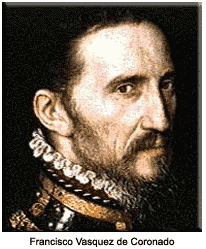 Born into a noble family in Salamanca, Spain, Francisco Vázquez de Coronado became acquainted with the prominent Antonio de Mendoza. When Mendoza was appointed viceroy of New Spain in 1535, he took Coronado along as an assistant.
Thriving in the New World, Coronado ensured his financial stability by marrying the daughter of the colonial treasurer and winning acclaim by ending a local slave revolt. He was rewarded by Mendoza with the governorship of Nueva Galicia in western Mexico in 1538.
Influenced by the almost unbelievable wealth of the Aztec and Inca empires, the Spanish conquerors were receptive to the belief that hoards of gold and silver existed elsewhere in the Americas. One report of extensive wealth came from Álvar Núñez Cabeza de Vaca, an explorer who had been shipwrecked off Florida in 1528 and spent the next six years wandering through present-day Texas and northern Mexico. Among the tales from his trek was a vague description of the fabled Seven Golden Cities of Cibola. Viceroy Mendoza dispatched a preliminary exploratory expedition north from Mexico; among this group was Fray Marcos de Niza, an imaginative friar who claimed to have viewed the cities from a distance.
In 1540, Coronado was given command of a major expedition comprising nearly 1,400 soldiers, slaves and natives, accompanied by a vast herd of cattle and sheep. The explorers were disappointed to find that Cibola, a Zuni settlement in present-day New Mexico, offered nothing in the way of riches. Coronado made a bad situation worse by ordering the Zuni to submit to the authority of the pope and the Spanish monarch. Resistance followed, but Spanish military might easily prevailed.
Coronado’s force was split into smaller exploratory parties. One traveled into modern Arizona and visited a number of Hopi villages; another party under García López de Cárdenas followed the Colorado River and became the first European group to behold the Grand Canyon.
The Spanish explorers spent the winter of 1540-41 at a site near present-day Santa Fe, New Mexico. In the spring, they moved eastward into Texas. Coronado, still intent upon finding gold, headed a small party in a search for the city of Quivira; they ventured as far north as Kansas, where they found only sparse native settlements. The disappointed Spaniards returned to the Santa Fe area for the winter of 1541-42 and then marched back to their homes in Mexico.
The inability of the expedition party to find mineral wealth ended the friendship between Coronado and Mendoza. Coronado managed to resume his position as provincial governor, but in 1544 lost that job as a result of his cruel treatment of the natives. He lived out his remaining months as a minor official in Mexico City.
Coronado’s exploits were illustrative of the Spaniards' consuming passion for gold and served as the basis of the Spanish claim to what became the southwestern United States.
Born into a noble family in Salamanca, Spain, Francisco Vázquez de Coronado became acquainted with the prominent Antonio de Mendoza. When Mendoza was appointed viceroy of New Spain in 1535, he took Coronado along as an assistant.
Thriving in the New World, Coronado ensured his financial stability by marrying the daughter of the colonial treasurer and winning acclaim by ending a local slave revolt. He was rewarded by Mendoza with the governorship of Nueva Galicia in western Mexico in 1538.
Influenced by the almost unbelievable wealth of the Aztec and Inca empires, the Spanish conquerors were receptive to the belief that hoards of gold and silver existed elsewhere in the Americas. One report of extensive wealth came from Álvar Núñez Cabeza de Vaca, an explorer who had been shipwrecked off Florida in 1528 and spent the next six years wandering through present-day Texas and northern Mexico. Among the tales from his trek was a vague description of the fabled Seven Golden Cities of Cibola. Viceroy Mendoza dispatched a preliminary exploratory expedition north from Mexico; among this group was Fray Marcos de Niza, an imaginative friar who claimed to have viewed the cities from a distance.
In 1540, Coronado was given command of a major expedition comprising nearly 1,400 soldiers, slaves and natives, accompanied by a vast herd of cattle and sheep. The explorers were disappointed to find that Cibola, a Zuni settlement in present-day New Mexico, offered nothing in the way of riches. Coronado made a bad situation worse by ordering the Zuni to submit to the authority of the pope and the Spanish monarch. Resistance followed, but Spanish military might easily prevailed.
Coronado’s force was split into smaller exploratory parties. One traveled into modern Arizona and visited a number of Hopi villages; another party under García López de Cárdenas followed the Colorado River and became the first European group to behold the Grand Canyon.
The Spanish explorers spent the winter of 1540-41 at a site near present-day Santa Fe, New Mexico. In the spring, they moved eastward into Texas. Coronado, still intent upon finding gold, headed a small party in a search for the city of Quivira; they ventured as far north as Kansas, where they found only sparse native settlements. The disappointed Spaniards returned to the Santa Fe area for the winter of 1541-42 and then marched back to their homes in Mexico.
The inability of the expedition party to find mineral wealth ended the friendship between Coronado and Mendoza. Coronado managed to resume his position as provincial governor, but in 1544 lost that job as a result of his cruel treatment of the natives. He lived out his remaining months as a minor official in Mexico City.
Coronado’s exploits were illustrative of the Spaniards' consuming passion for gold and served as the basis of the Spanish claim to what became the southwestern United States.